Graph Labelings: A Prime Area to Explore
- First Online: 05 July 2022

Cite this chapter

- Elizabeth A. Donovan 5 &
- Lesley W. Wiglesworth 6
Part of the book series: Foundations for Undergraduate Research in Mathematics ((FURM))
611 Accesses
A graph labeling assigns integers to the vertices or edges (or both) of a graph, subject to certain conditions. Labelings were first studied in the late 1960s, making them a relatively new area of mathematics to explore. There are hundreds of different types of labelings, many of which are motivated by circuit design, coding theory, and communication networks. In this chapter, we introduce the reader to prime labelings, a labeling of the vertices in such a way that the labels of adjacent vertices are relatively prime. We also introduce several variations of prime labelings while guiding the reader through examples and existing research. We present the reader with several research questions for each variation, several of which have never been explored, thus allowing the reader to make progress on new problems.
This is a preview of subscription content, log in via an institution to check access.
Access this chapter
Subscribe and save.
- Get 10 units per month
- Download Article/Chapter or Ebook
- 1 Unit = 1 Article or 1 Chapter
- Cancel anytime
- Available as PDF
- Read on any device
- Instant download
- Own it forever
- Available as EPUB and PDF
- Compact, lightweight edition
- Dispatched in 3 to 5 business days
- Free shipping worldwide - see info
- Durable hardcover edition
Tax calculation will be finalised at checkout
Purchases are for personal use only
Institutional subscriptions
Similar content being viewed by others

Combinatorial Questions: How Can Graph Labelling Help?

Some of My Favorite Coloring Problems for Graphs and Digraphs

Graph Edge Coloring: A Survey
Ablondi, T., Hayes, A. and Wiglesworth, L. W. Results on Neighborhood-Prime Labelings of Graphs. Preprint (2019).
Google Scholar
Asplund, J., Fox, B.N.: Minimum Coprime Labelings for Operations on Graphs. Integers. 19 (2019).
Asplund, J., Fox, N. B., Hamm, A. New Perspectives on Neighborhood-Prime Labelings of Graphs. Arxiv preprint, arXiv:1804.02473 (2018).
Benjamin, A., Chartrand, G., Zhang, P.: Fascinating World of Graph Theory. Princeton University Press, Princeton (2015).
Book MATH Google Scholar
Berliner, A.H., Dean, N., Hook, J., Marr, A., Mbirika, A., McBee, C.D.: Coprime and prime labelings of graphs. Journal of Integer Sequences, 19 (2), 1–14 (2016).
MathSciNet MATH Google Scholar
Bigham, A., Donovan, E.A., Pack, J., Turley, J., Wiglesworth, L.W.: Prime Labelings of Snake Graphs. The PUMP Journal of Undergraduate Research. 2 , 131–149 (2019).
Chartrand, G., Polimeni, A., and Zhang, P. Mathematical Proofs: A Transition to Advanced Mathematics, 4th ed. Pearson, 2018.
Cloys, M. and Fox, N. B. Neighborhood-Prime Labelings of Trees and Other Classes of Graphs. Arxiv preprint, arXiv:1801.01802 (2018).
Deretsky, T., Lee, S., Mitchem, J.: On vertex prime labelings of graphs. Proceedings of the 6th International Conference Theory and Applications of Graphs. 359–369 (1991).
Donovan, E., Hoard, E., Lyu, Y. and Sutton, K. On the Prime Labeling of the Disjoint Union of Cycles. Preprint (2019).
Gallian, J.A.: A dynamic survey of graph labeling. The Electronic Journal of Combinatorics. 16 (6). 1–219 (2009). Version 23 available at https://www.combinatorics.org/ojs/index.php/eljc/article/view/DS6/pdf .
MathSciNet Google Scholar
“Königsberg Bridges.” The MacTutor History of Mathematics Archive: http://www-history.mcs.st-and.ac.uk/history/Miscellaneous/other_links/Konigsberg.html Cited December 1, 2020.
Lee, J. Some Remarks on Writing Mathematical Proofs. https://sites.math.washington.edu/~lee/Writing/writing-proofs.pdf . Cited 18 December 2020.
Lee, S.M., Wui, I., Yeh, J.: On the Amalgamation of Prime Graphs. Bulletin of the Malaysian Mathematical Sciences Society (Second Series). 11 , 59–67 (1988).
Levin, O. Discrete Mathematics: An Open Introduction, 3 r d ed. Retrieved from: http://discrete.openmathbooks.org/dmoi3.html .
Patel, S. K., Shrimali, N. P.: Neighborhood-prime labeling. International Journal of Mathematics and Soft Computing. 5 (2), 135–143 (2015).
Article Google Scholar
Rosa, A.: On certain valuations of the vertices of a graph. Theory of Graphs (Internat. Symposium, Rome, July 1966). Gordon and Breach, N. Y. and Dunod Paris, 349–355 (1967).
Schluchter, S.A., Schroeder, J.Z., Cokus, K., Ellingson, R., Harris, H., Rarity, E., Wilson, T: Prime labelings of generalized Petersen graphs. Involve, a Journal of Mathematics. 10 (1), 109–124 (2016).
Sundstrom, T. Mathematical Reasoning: Writing and Proof, Version 3. Creative Commons, 2020. Retrieved from https://scholarworks.gvsu.edu/books/24/ . Cited 18 December 2020.
Tout, R., Dabboucy, A., Howalla, K.: Prime labeling of graphs. National Academy Science Letters-India. 5 (11), 365–368 (1982).
MATH Google Scholar
Trudeau, R. J.: Introduction to Graph Theory. Dover, New York (1994).
Vaidya, S.K. and Prajapati, U. M. Some new results on prime graph. Open Journal of Discrete Mathematics. 2 (3), 99–104 (2012).
Weisstein, Eric W.“Trees.” From MathWorld–A Wolfram Web Resource. Retrieved from https://mathworld.wolfram.com/topics/Trees.html . Cited 20 December 2020.
West, D.B.: Introduction to Graph Theory (2nd ed). Prentice Hall, Upper Saddle River (2001).
Download references
Author information
Authors and affiliations.
Department of Mathematics and Statistics, Murray State University, Murray, KY, USA
Elizabeth A. Donovan
Department of Mathematics, Centre College, Danville, KY, USA
Lesley W. Wiglesworth
You can also search for this author in PubMed Google Scholar
Corresponding author
Correspondence to Elizabeth A. Donovan .
Editor information
Editors and affiliations.
Mathematics, University of Portland, Portland, OR, USA
Eli E. Goldwyn
Mathematics & Computer Science, St. Mary’s College of Maryland, St. Mary’s City, MD, USA
Sandy Ganzell
Aaron Wootton
Rights and permissions
Reprints and permissions
Copyright information
© 2022 The Author(s), under exclusive license to Springer Nature Switzerland AG
About this chapter
Donovan, E.A., Wiglesworth, L.W. (2022). Graph Labelings: A Prime Area to Explore. In: Goldwyn, E.E., Ganzell, S., Wootton, A. (eds) Mathematics Research for the Beginning Student, Volume 1. Foundations for Undergraduate Research in Mathematics. Birkhäuser, Cham. https://doi.org/10.1007/978-3-031-08560-4_4
Download citation
DOI : https://doi.org/10.1007/978-3-031-08560-4_4
Published : 05 July 2022
Publisher Name : Birkhäuser, Cham
Print ISBN : 978-3-031-08559-8
Online ISBN : 978-3-031-08560-4
eBook Packages : Mathematics and Statistics Mathematics and Statistics (R0)
Share this chapter
Anyone you share the following link with will be able to read this content:
Sorry, a shareable link is not currently available for this article.
Provided by the Springer Nature SharedIt content-sharing initiative
- Publish with us
Policies and ethics
- Find a journal
- Track your research

Graph Labeling
- Joseph A. Gallian
A graph labeling is an assignment of integers to the vertices or edges, or both, subject to certain conditions. Graph labelings were first introduced in the mid 1960s. In the intervening 50 years nearly 200 graph labelings techniques have been studied in over 2000 papers. Finding out what has been done for any particular kind of labeling and keeping up with new discoveries is difficult because of the sheer number of papers and because many of the papers have appeared in journals that are not widely available. In this survey, I have collected everything I could find on graph labeling. For the convenience of the reader the survey includes a detailed table of contents and index. This edition has 55 additional pages and 308 new references that are identified with the reference number and the word “new” in the right margin.
- Original research
- Open access
- Published: 09 July 2019
Edge even graceful labeling of some graphs
- Mohamed R. Zeen El Deen ORCID: orcid.org/0000-0002-1100-3309 1
Journal of the Egyptian Mathematical Society volume 27 , Article number: 20 ( 2019 ) Cite this article
10k Accesses
7 Citations
Metrics details
Edge even graceful labeling is a new type of labeling since it was introduced in 2017 by Elsonbaty and Daoud (Ars Combinatoria 130:79–96, 2017). In this paper, we obtained an edge even graceful labeling for some path-related graphs like Y- tree, the double star B n , m , the graph 〈 K 1,2 n : K 1,2 m 〉, the graph \( ~P_{2n-1}\odot \overline { K_{2m}}~ \) , and double fan graph F 2, n . Also, we showed that some cycle-related graphs like the prism graph \( ~\prod _{n}~ \) , the graph \( ~C_{n}\left (\frac {n}{2}\right)~ \) , the flag FL n , the graph K 2 ⊙ C n , the flower graph FL( n ), and the double cycle { C n , n } are edge even graphs.
Introduction
A graph labeling is an assignment of integers to the edges or vertices, or both, subject to certain condition. The idea of graph labelings was introduced by Rosa in [ 1 ]. Following this paper, other studies on different types of labelings (Odd graceful, Chordal graceful, Harmonious, edge odd graceful) introduced by many others [ 2 – 4 ]. A new type of labeling of a graph called an edge even graceful labeling has been introduced by Elsonbaty and Daoud [ 5 ]. They introduced some path- and cycle-related graphs which are edge even graceful.
Graph labelings give us useful models for a wide range of applications such as coding theory, X-ray, astronomy, radar, and communication network addressing.
Definition 1
[ 5 ] An edge even graceful labeling of a graph G ( V ( G ), E ( G )) with p =| V ( G )| vertices and q =| E ( G )| edges is a bijective mapping f of the edge set E ( G ) into the set {2,4,6, ⋯ ,2 q } such that the induced mapping f ∗ : V ( G ) →{0,2,4, ⋯ ,2 q }, given by: \( f^{\ast }(x) = \left ({\sum \nolimits }_{xy \in E(G)} f(xy)~ \right)~mod~(2k) \) , is an injective function, where k = m a x ( p , q ). The graph that admits an edge even graceful labeling is called an edge even graceful graph.
In Fig. 1 , we present an edge even graceful labeling of the Peterson graph and the complete graph K 5 .

An edge even graceful labeling of Peterson graph and the complete graph K 5
Edge even graceful for some path related graphs
A Y- tree is a graph obtained from a path by appending an edge to a vertex of a path adjacent to an end point, and it is denoted by Y n where n is the number of vertices in the tree.
The Y-tree Y n is an edge even graceful graph when n is odd.
The number of vertices of Y-tree Y n is n and the number of edges is n −1. Let the vertices and the edges of Y n be given as in Fig. 2 .

Y n with ordinary labeling
We define the mapping f : E ( Y n ) →{2,4, ⋯ ,2 n −2} as follows:
Then, the induced vertex labels are
Similarly, \( ~~~f^{\ast }\left (v_{\frac {n+3}{2}}\right)= 6~,~~~~~~~~~~~~~ f^{\ast }\left (v_{\frac {n+5}{2}}\right)= 8~, f^{\ast }\left (v_{\frac {n+7}{2}}\right)= 10 ~\) ,
Clearly, all the vertex labels are even and distinct. Thus, Y-tree Y n is an edge even graceful graph when n is odd. □
Illustration: The edge even labeling of the graph Y 13 is shown in Fig. 3 .

The edge even labeling of the graph Y 13
Double star is the graph obtained by joining the center of the two stars K 1, n and K 1, m with an edge, denoted by B n , m . The graph B n , m has p = n + m +2 and q = n + m +1.
The double star B n , m is edge even graceful graph when one ( m o r n ) is an odd number and the other is an even number.
Without loss of generality, assume that n is odd and m is even. Let the vertex and edge symbols be given as in Fig. 4 .
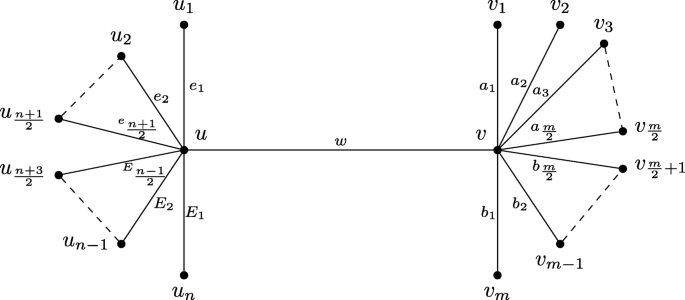
B m , n with ordinary labeling
Define the mapping f : E ( B m , n ) →{2,4, ⋯ ,2 q } as follows:
We realize the following:
So, the vertex labels will be
Also, each pendant vertex takes the labels of its incident edge which are different from the labels of the vertices U and v . □
The graph 〈 K 1, n : K 1, m 〉 is obtained by joining the center v 1 of the star K 1, n and the center v 2 of the another star K 1, m to a new vertex u , so the number of vertices is p = n + m +3 and the number of edges is q = n + m +2.
The graph 〈 K 1,2 n : K 1,2 m 〉 is an edge even graceful graph.
Let the vertex and edge symbols be given as in Fig. 5 .

〈 K 1,2 n : K 1,2 m 〉 with ordinary labeling
Define the mapping f : E ( G ) →{2,4, ⋯ ,2 p } as follows:
We can see the following:
which are even and distinct from each pendant vertices. Thus, the graph 〈 K 1,2 n : K 1,2 m 〉 is an edge even graceful graph. □
The corona [ 6 ] \( ~P_{3}\odot \overline { K_{2m}}~ \) is an edge even graceful graph.
In this graph p =6 m +3 and q =6 m +2. Let the vertex and edge symbols be given as in Fig. 6 .

\( ~P_{3}\odot \overline { K_{2m}}~ \) with ordinary labeling
We can define the mapping \(f: E(P_{3}\odot \overline { K_{2m}}~)~\rightarrow \{2,4,\cdots, 2q \}\) as follows:
It is clear that f ( A ij )+ f ( B ij )≡0 mod (2 p ) for j =1,2, ⋯ , m
So the vertex labels will be,
Therefore, all the vertices are even and distinct which complete the proof. □
Illustration: The edge even labeling of the graph \( ~P_{3}\odot \overline { K_{6}}~ \) is shown in Fig. 7 .

Edge even graceful labeling of the graph \( ~P_{3}\odot \overline { K_{6}}~ \)
The generalization of the previous result is presented in the following theory
The graph \( ~P_{2n-1}\odot \overline { K_{2m}}~ \) is an edge even graceful graph.
In this graph, p =4 n m +2( n − m )−1 and q =4 n m +2( n − m )−2. The middle vertex in the path P 2 n −1 will be v n , and we start the labeling from this vertex. Let the vertex and edge symbols be given as in Fig. 8 .

\( ~P_{2n-1}\odot \overline { K_{2m}}~ \) with ordinary labeling
Define the mapping f : E ( G ) →{2,4, ⋯ ,2 q } by the following arrangement
f ( e i )=2 i for i =1,2, ⋯ , n −1
f ( b i )=2 p − 2 i for i =1,2, ⋯ , n −1
f ( A ij ) will take any number from the reminder set of the labeling not contains 2 i nor 2 p − 2 i for j =1,2, ⋯ , m and
f ( D ij )=2 p −[ f ( A ij )] for j =1,2, ⋯ , m .
It is clear that [ f ( A ij )+ f ( D ij )] mod (2 p )≡0 mod (2 p ) for j =1,2, ⋯ , m .
f ∗ ( v n )=[ f ( e 1 )+ f ( b 1 )] mod (2 p ) ≡0 mod (2 p ),
For any vertex v k when k < n , let k = n − i and i =1,2, ⋯ , n −2
When k > n , let k = n + i and i =1,2, ⋯ , n −2
The pendant vertices v 1 a n d v 2 n −1 of the path P 2 n −1 will take the labels of its pendant edges of P 2 n −1 ,i.e.,
If n is even, then f ∗ ( v 1 )= f ( e n −1 ), and f ∗ ( v 2 n −1 )= f ( b n −1 )
If n is odd, then f ∗ ( v 1 )= f ( b n −1 ), and f ∗ ( v 2 n −1 )= f ( e n −1 )
Then, the labels of the vertices of the path P 2 n −1 takes the labels of the edges of the path P 2 n −1 , and each pendant vertex takes the labels of its incident edge. Then, there are no repeated vertex labels, which complete the proof. □
Illustration: The graph \( ~P_{11}\odot \overline { K_{4}}~ \) labeled according to Theorem 1 is presented in Fig. 9 .

Edge even graceful labeling of the graph \( ~P_{11}\odot \overline { K_{4}}~ \)
A double fan graph F 2, n is defined as the graph join \(\overline {K_{2}} + P_{n}~\) where \(\overline {K_{2}} \) is the empty graph on two vertices and P n be a path of length n .
The double fan graph F 2, n is an edge even graceful labeling when n is even.
In the graph F 2, n we have p = n +2 a n d q =3 n −1. Let the graph F 2, n be given as indicated in Fig. 10 .
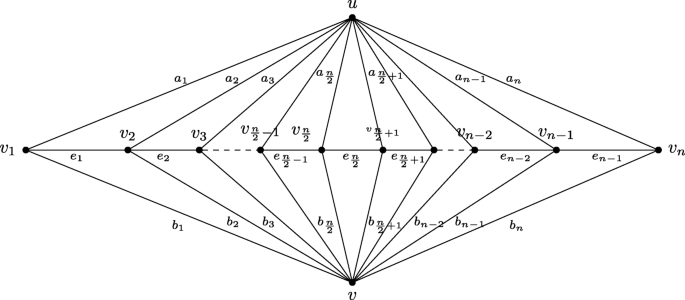
F 2, n with ordinary labeling
Define the edge labeling function f : E ( F 2, n )→ {2,4, ⋯ , 6 n −2} as follows:
f ( a i )=2 i ; i =1,2, ⋯ n
f ( b i )=2 q −2 i =6 n −2( i +1); i =1,2, ⋯ n
Hence, the induced vertex labels are
\(~ f^{\ast }(u) = \left (\sum _{i=1}^{n}(f(a_{i}))\right)~\text {mod}(6n-2)\,=\, \left (\sum _{i=1}^{n}(2i)\right)~\text {mod}(6n-2) =(n^{2}+n)~\text {mod}(6n-2)~~\)
\(~ f^{\ast }(v) = \left (\sum _{i=1}^{n}(f(b_{i})) \right)~\text {mod}(6n-2)= \left (\sum _{i=1}^{n}(2q-2i)\right)~\text {mod}(6n-2) =\left (- n^{2}-n\right)~\text {mod}(6n-2) \)
\( f^{\ast }(v_{i}) \,=\, \left [\sum _{i=1}^{n}(f(a_{i})\,+\,f(b_{i})\,+\,f (e_{i}) \,+\,f(e_{i-1}))\right ]~\text {mod}(6n\,-\,2)~ \,=\,(4n\,+\,4i\,-\,2)~\text {mod}(6n\,-\,2)~,~~2 \leq i \leq \frac {n}{2}- 1 \)
\(f^{\ast }(v_{i}) = \left [\sum _{i=1}^{n}(f(a_{i})+f(b_{i})+f (e_{i}) +f(e_{i-1}))\right ]~\text {mod}(6n-2) =(4n+4i-6)~\text {mod}(6n-2),~~\frac {n}{2}+2 \leq i \leq n- 1 \)
Since [ f ( a i )+ f ( b i )] mod(6 n −2)=0, we see that
f ∗ ( v 1 )= f ( e 1 )=2 n +2,
f ∗ ( v n )= f ( e n −1 )=4 n −4,
\(~~~~~ f^{\ast }(v_{\frac {n}{2}})=~f (e_{\frac {n}{2}-1})= 3n-2 ~\) and
\( ~~~~f^{\ast }(v_{\frac {n}{2}+1})=~f (e_{\frac {n}{2}})= 3n ~\)
Thus, the set of vertices \( v_{1}, v_{2},v_{3},\cdots ~,v_{\frac {n}{2}-1},v_{\frac {n}{2} },v_{\frac {n}{2}+1},v_{\frac {n}{2}+2},v_{\frac {n}{2}+3},\cdots ~,v_{n-2},v_{n-1},v_{n} \) are labeled by 2 n +2, 4 n +6, 4 n +10, ⋯ ,6 n −6, 3 n −2, 3 n , 4,8, ⋯ ,2 n −12, 2 n −8, 4 n −4 respectively.
Clearly, f ∗ ( u ) and f ∗ ( v ) are different from all the labels of the vertices. Hence F 2, n is an edge even graceful when n is even. □
Illustration: The double fan F 2,10 labeled according to Theorem 2 is presented in Fig. 11 .
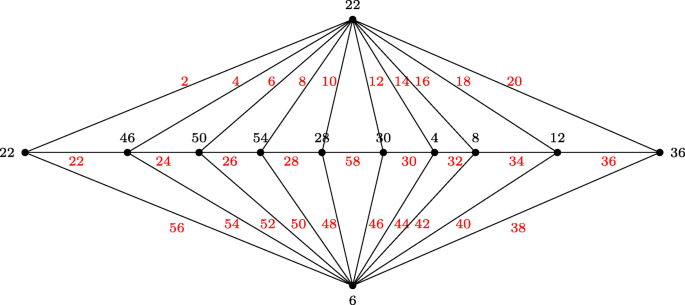
Edge even graceful labeling of the double fan F 2,10
Edge even graceful for some cycle related graphs
Definition 2.
For n ≥4, a cycle (of order n) with one chord is a simple graph obtained from an n -cycle by adding a chord. Let the n -cycle be v 1 v 2 ⋯ v n v 1 . Without loss of generality, we assume that the chord joins v 1 with any one v i , where 3≤ i ≤ n −1. This graph is denoted by C n ( i ).
The graph \( ~C_{n}\left (\frac {n}{2}\right)~ \) is an edge even graceful graph if n is even.
Let \( \{ v_{1}, v_{2},\cdots, v_{\frac {n}{2}-1},v_{\frac {n}{2}},v_{\frac {n}{2}+1}, \cdots,v_{n} \}\) be the vertices of the graph \(C_{n}\left (\frac {n}{2}\right)\) , and the edges are e i =( v i v i +1 ) for i ≤ i ≤ n −1 and the chord \(e_{0}=(v_{1}v_{\frac {n}{2}}) \) connecting the vertex v 1 with \(v_{\frac {n}{2}}\) as in Fig. 12 .
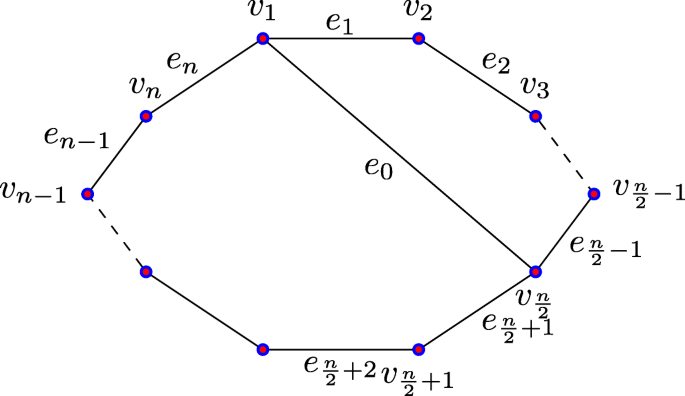
\( ~C_{n}\left (\frac {n}{2}\right)~ \) with ordinary labeling
Here, p = n and q = n +1, so 2 k =2 q =2 n +2; first, we label the edges as follows:
Then, the induced vertex labels are as follows:
for any other vertex \(~~~v_{i}, ~~~i\neq 1,\frac {n}{2}\)
Hence, the labels of the vertices \(v_{0}, v_{1},v_{2}, \cdots,v_{\frac {n}{2}-1},v_{\frac {n}{2}},v_{\frac {n}{2}+1}, \cdots v_{n} \) are 6, 10, 14, ⋯ , 2 n −2, 2, 4, ⋯ , 2 n respectively, which are even and distinct. So, the graph \( ~C_{n}\left (\frac {n}{2}\right)~ \) is an edge even graceful graph if n is even. □
Definition 3
Let C n denote the cycle of length n . The flag F L n is obtained by joining one vertex of C n to an extra vertex called the root, in this graph p = q = n +1.
The flag graph F L n is edge even graceful graph when n is even.
Let { v 1 , v 2 , ⋯ , v n } be the vertices of the cycle C n and the edges are e i =( v i v i +1 ) f o r 1≤ i ≤ n and the edge e =( v 1 v 0 ) connecting the vertex v 1 with v 0 as in Fig. 13 .
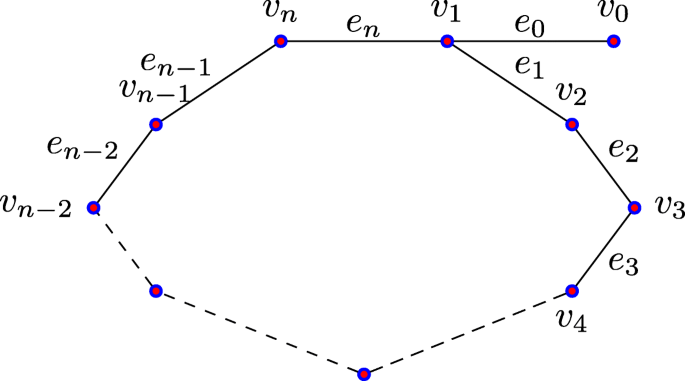
F l n with ordinary labeling
First, we label the edges as follows:
Then, the induced vertex labels are as follows f ∗ ( v 0 )= f ( e 0 )=2,
Hence, the labels of the vertices \(v_{0}, v_{1},v_{2}, \cdots,v_{\frac {n}{2}-1},v_{\frac {n}{2}},v_{\frac {n}{2}+1}, \cdots v_{n} \) will be 2, 6, 10, 14, ⋯ , 2 n −2, 0, 4, ⋯ , 2 n respectively. □
The graph K 2 ⊙ C n is edge even graceful graph when n is odd.
Let \( \left \{ v_{1}, v_{2},\cdots, v_{n},v^{'}_{1},v^{'}_{2}, \cdots,v^{'}_{n} \right \}\) be the vertices of the graph K 2 ⊙ C n and the edges are \( \left \{e_{1}, e_{2},\cdots, e_{n},~e^{'}_{1},e^{'}_{2}, \cdots,e^{'}_{n} \right \}\) as shown in Fig. 14 . Here, p =2 n and q =2 n +1, so 2 k =4 n +2.

The graphs K 2 ⊙ C n with ordinary labeling
We can see that [ f ( e n )+ f ( e n +1 )]mod(2 q )=(4 n +2) mod(4 n +2)≡0
Then, the induced vertex labels are as follows
\( f^{\ast }(v^{\prime }_{i})= \left [ f(e^{\prime }_{i}) +f(e^{\prime }_{i+1})\right ]~\text {mod}(4n+2)=[8+4~(i-1)]~\text {mod}(4n+2)~,~~1 \leq i < n \)
f ∗ ( v n )= [ f ( e 1 )+ f ( e n )+ f ( e n +1 ) ] mod(4 n +2)= f ( e 1 ) mod(4 n +2) ≡2
\( ~~~f^{\ast }(v^{\prime }_{n})=~ \left [ f(e^{\prime }_{1}) +f(e_{n+1})~+~f\left (e^{\prime }_{n}\right)\right ]~\text {mod}(4n+2) ~\equiv ~4\)
Clearly, the vertex labels are all even and distinct. Hence, the graph K 2 ⊙ C n is edge even graceful for odd n . □
Let C n denote the cycle of length n . Then, the corona of all vertices of C n except one vertex { v 1 } with the complement graph \(\overline {K_{2m-1}}\) is denoted by \( ~ \{C_{n}-\{v_{1} \} \} \odot \overline {K_{2m-1}}~ \) , in this graph p = q =2 m ( n −1)+1.
The graph \( \{C_{n}-\{v_{1} \} \} \odot \overline {K_{2m-1}}~ \) is an edge even graceful graph.
Let the vertex and edge symbols be given as in Fig. 15 .
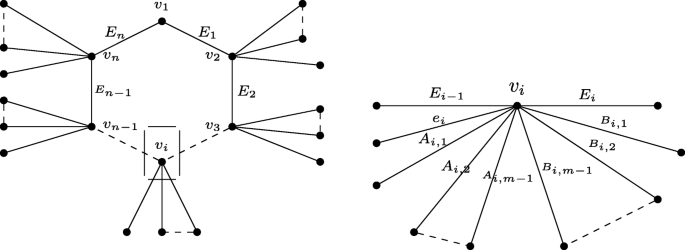
\( ~ \{C_{n}-\{v_{1} \} \} \odot \overline {K_{2m-1}}~ \) with ordinary labeling
Define the mapping f : E ( G ) →{2,4, ⋯ ,2 q } as follows:
[ f ( A ij )+ f ( B ij )] mod (2 q )≡0 mod (2 q ) for j =1,2, ⋯ , m −1
Also, [ f ( E i −1 )+ f ( e i )] mod (2 q )≡0 mod (2 q ) f o r i =2,3, ⋯ , n
So, verifying the vertex labels, we get that,
f ∗ ( v 1 )=[ f ( E 1 )+ f ( E n )] mod (2 q )=(2+2 q ) mod (2 q )=2,
Hence, the labels of the vertices v 1 , v 2 , ⋯ , v n takes the label of the edges of the cycles and each of the pendant vertices takes the label of its edge, so they are all even and different numbers. □
Illustration: In Fig. 16 , we present an edge even graceful labeling of the graph \( ~ \{C_{6}-\{v_{1} \} \} \odot \overline {K_{3}}~ \) .
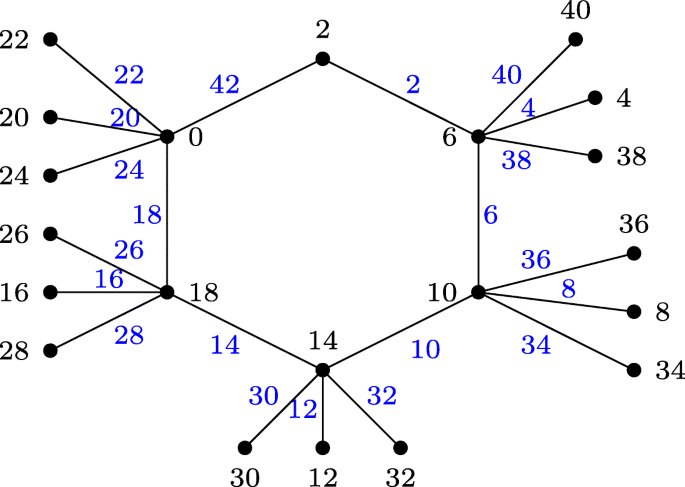
\( ~ \{C_{6}-\{v_{1} \} \} \odot \overline {K_{3}}~ \)
The double cycle graph { C n , n } is an edge even graceful graph when n is odd.
Here, p = n and q =2 n . Let the vertex and edge symbols be given as in Fig. 17 .
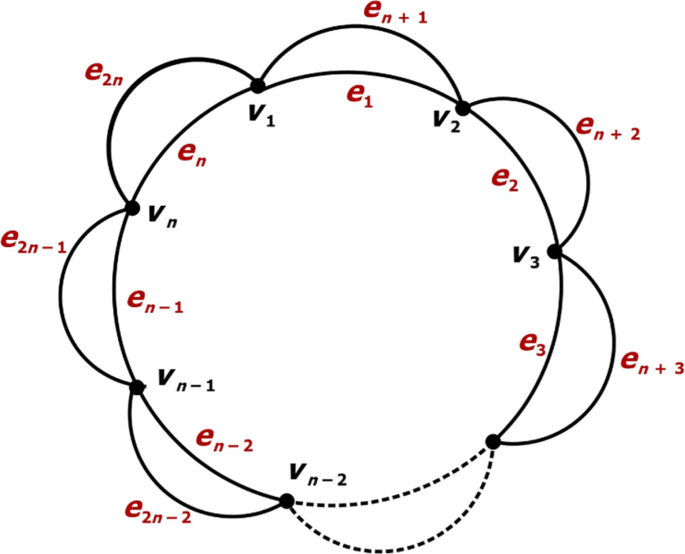
{ C n , n } with ordinary labeling
Define the mapping f : E ( G ) →{2,4, ⋯ ,4 n } by
f ( e i )=2 i for i =1,2, ⋯ , n . So, the vertex labels will be
f ∗ ( v 1 )=[ f ( e 1 )+ f ( e n ) + f ( e n +1 ) + f ( e 2 n )]mod (4 n )=4
Hence, the labels of the vertices \( v_{1},v_{2},v_{3}, \cdots, v_{\frac {n+1}{2}}, v_{\frac {n+3}{2}}, \cdots, v_{n} \) will be 4,12,20, ⋯ ,0,8, ⋯ ,4 n −4 □
The prism graph \( \prod _{n}\) is the cartesian product C n □ K 2 of a cycle C n by an edge K 2 , and an n -prism graph has p =2 n vertices and q =3 n edges.
The prism graph \( ~\prod _{n}~ \) is edge even graceful graph.
In the prism graph \( \prod _{n}\) we have two copies of the cycle C n , let the vertices in one copy be v 1 , v 2 , ⋯ , v n and the vertices on the other copy be \(~v^{\prime }_{1}, v^{\prime }_{2}, \cdots, v^{\prime }_{n}~\) . In \( ~\prod _{n}~ \) , the edges will be
\(v_{i}v_{i+1}, ~~ ~~~v^{\prime }_{i}v^{\prime }_{i+1},~~~ \text {and} ~~~v_{i}v^{\prime }_{i} \) . Let the vertex and edge symbols be given as in Fig. 18 .
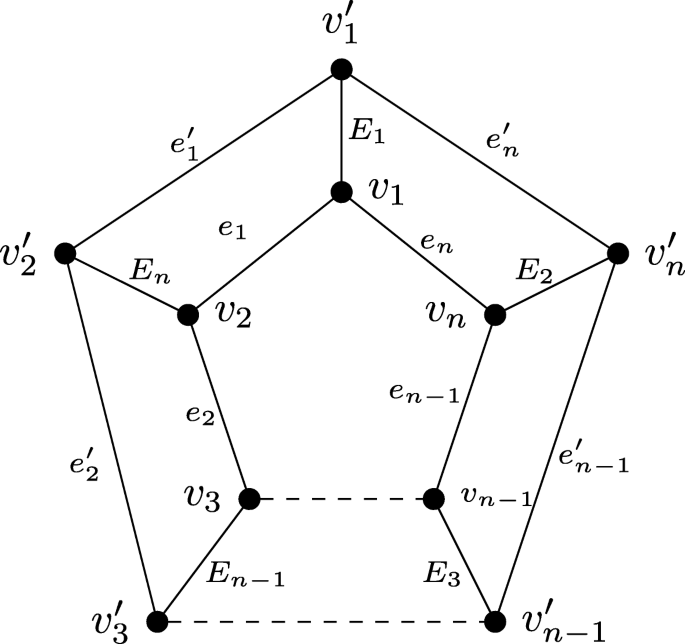
\( ~\prod _{n}~ \) with ordinary labeling
Define the mapping \(f: E\left (\prod _{n}\right)~\rightarrow \{2,4,\cdots, 6n \}\) by
Hence, the labels of the vertices v 1 , v 2 , ⋯ , v n will be 4 n +4, 4 n +6, ⋯ ,0, 2 respectively.
Also, \( f^{\ast }(v^{\prime }_{1}) = \left [~ f(e^{\prime }_{1}) +f(e^{\prime }_{n})~+ f(E_{1})\right ] \text {mod}~(6n)= 12n+ 4~ \text {mod}~(6n)= 4\)
Hence, the labels of the vertices \( v^{\prime }_{1},v^{\prime }_{2}, \cdots, v^{\prime }_{n} \) are 4, 6,8, ⋯ ,2 n , 2 n +2 respectively. Overall, the vertices are even and different. Thus, the prism graph \( ~\prod _{n}~ \) is an edge even graceful graph. □
Illustration: In Fig. 19 , we present an edge even graceful labeling of of prism graphs \( ~\prod _{5}~ \) and \( ~\prod _{6} \) .
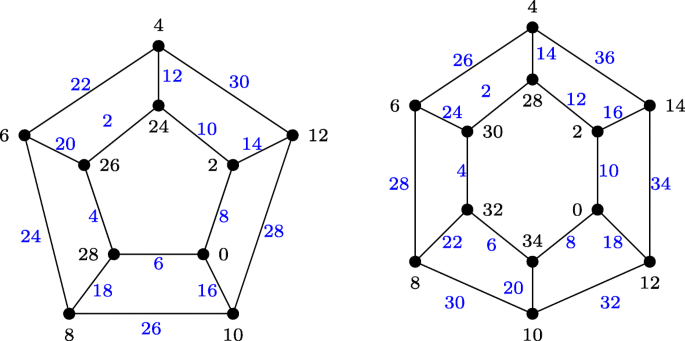
An edge even graceful labeling of prism graphs \( ~\prod _{5}~ \) and \( ~\prod _{6} \)
The flower graph FL( n ) ( n ≥3) is the graph obtained from a helm H n by joining each pendant vertex to the center of the helm.
The flower graph FL(n) ( n ≥4) is an edge even graceful graph.
In the flower graph FL( n ) ( n ≥4), we have p =2 n +1 and q =4 n . Let \(\{~v_{0},v_{1}, v_{2}, \cdots, v_{n}~,v^{\prime }_{1}, v^{\prime }_{2}, \cdots, v^{\prime }_{n}\}\) be the vertices of FL( n ) and
{ e 1 , e 2 , e 3 , ⋯ , e 3 n , E 1 , E 2 , E 3 , ⋯ , E n } be the edges of FL( n ) as in Fig. 20 .
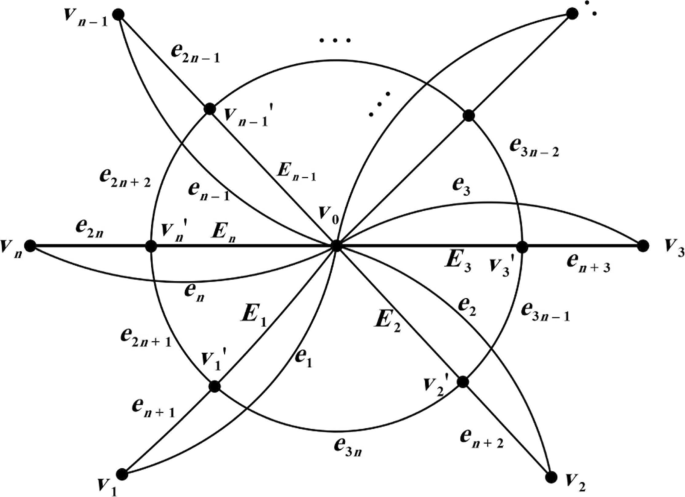
The flower graph FL(n) with ordinary labeling
First, define the mapping f : E ( F l ( n ))→{2,4, ⋯ ,8 n } as the following:
Overall, all the vertex labels are even and distinct which complete the proof. □
Illustration: In Fig. 21 , we present an edge even graceful labeling of of the flower graphs FL(6)and FL(7).
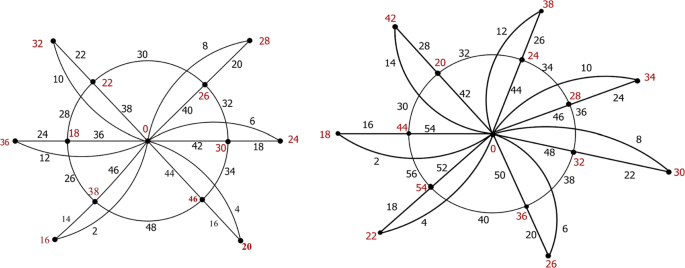
An edge even graceful labeling of The flower graphs FL(6) and FL(7)
Rosa, A.: Certain valuations of the vertices of a graph; Theory of Graphs (Internat. Symp, Rome, July 1966). Gordan and Breach, New York (1967). Paris, France.
Google Scholar
Gallian, J. A.: A Dynamic survey of graph labeling. The Electronic Journal of Combinatorics (2015). http://link.springer.com/10.1007/978-1-84628-970-5 .
Daoud, S. N.: Edge odd graceful labeling of some path and cycle related graphs. AKCE International Journal of Graphs and Combinatorics. 14, 178–203 (2017). https://doi.org/10.1016/j.akcej.2017.03.001 .
Article MathSciNet Google Scholar
Seoud, M. A., Salim, M. A.: Further results on edge-odd graceful graphs. Turkish J. Math. 40(3), 647–656 (2016). https://journals.tubitak.gov.tr/math/ .
Elsonbaty, A., Daoud, S. N.: Edge even graceful labeling of some path and cycle related graphs. Ars Combinatoria. 130(2), 79–96 (2017).
MathSciNet MATH Google Scholar
Bondy, J. A., Murty, U. S.: Graph Theory. Springer (2008). http://link.springer.com/10.1007/978-1-84628-970-5 .
Download references
Acknowledgments
I am so grateful to the reviewers for their valuable suggestions and comments that significantly improved the paper.
Not applicable.
Availability of data and materials
Author information, authors and affiliations.
Department of Mathematics, Faculty of Science, Suez University, Suez, 43527, Egypt
Mohamed R. Zeen El Deen
You can also search for this author in PubMed Google Scholar
Contributions
The author read and approved the final manuscript.
Corresponding author
Correspondence to Mohamed R. Zeen El Deen .
Ethics declarations
Competing interests.
The author declares that he has no competing interests.
Publisher’s Note
Springer Nature remains neutral with regard to jurisdictional claims in published maps and institutional affiliations.
Rights and permissions
Open Access This article is distributed under the terms of the Creative Commons Attribution 4.0 International License( http://creativecommons.org/licenses/by/4.0/ ), which permits unrestricted use, distribution, and reproduction in any medium, provided you give appropriate credit to the original author(s) and the source, provide a link to the Creative Commons license, and indicate if changes were made.
Reprints and permissions
About this article
Cite this article.
Zeen El Deen, M.R. Edge even graceful labeling of some graphs. J Egypt Math Soc 27 , 20 (2019). https://doi.org/10.1186/s42787-019-0025-x
Download citation
Received : 10 January 2019
Accepted : 22 February 2019
Published : 09 July 2019
DOI : https://doi.org/10.1186/s42787-019-0025-x
Share this article
Anyone you share the following link with will be able to read this content:
Sorry, a shareable link is not currently available for this article.
Provided by the Springer Nature SharedIt content-sharing initiative
- Edge-even graceful labeling
- Flag graph FL n
- Double fan graph F 2, n
- Prism graph
- The flower graph FL( n )
Mathematics subject classification
graceful labeling Recently Published Documents
Total documents.
- Latest Documents
- Most Cited Documents
- Contributed Authors
- Related Sources
- Related Keywords
An efficient encryption process with graceful labeling – A hybrid approach
New classes of graphs with edge $ \; \delta- $ graceful labeling.
<abstract><p>Graph labeling is a source of valuable mathematical models for an extensive range of applications in technologies (communication networks, cryptography, astronomy, data security, various coding theory problems). An edge $ \; \delta - $ graceful labeling of a graph $ G $ with $ p\; $ vertices and $ q\; $ edges, for any positive integer $ \; \delta $, is a bijective $ \; f\; $ from the set of edge $ \; E(G)\; $ to the set of positive integers $ \; \{ \delta, \; 2 \delta, \; 3 \delta, \; \cdots\; , \; q\delta\; \} $ such that all the vertex labels $ \; f^{\ast} [V(G)] $, given by: $ f^{\ast}(u) = (\sum\nolimits_{uv \in E(G)} f(uv)\; )\; mod\; (\delta \; k) $, where $ k = max (p, q) $, are pairwise distinct. In this paper, we show the existence of an edge $ \; \delta- $ graceful labeling, for any positive integer $ \; \delta $, for the following graphs: the splitting graphs of the cycle, fan, and crown, the shadow graphs of the path, cycle, and fan graph, the middle graphs and the total graphs of the path, cycle, and crown. Finally, we display the existence of an edge $ \; \delta- $ graceful labeling, for the twig and snail graphs.</p></abstract>

ODD GRACEFUL LABELING OF PATH UNION OF CATERPILLARS
Graceful labeling of digraphs—a survey, graceful labeling of power graph of group z2k−1 × z4.
The power graph of a finite group G is a special type of undirected simple graph whose vertex set is set of elements of G, in which two distinct vertices of G are adjacent if one is the power of other. Let [Formula: see text] be a finite abelian 2-group of order [Formula: see text] where [Formula: see text]. In this paper, we establish that the power graph of finite abelian group G always has graceful labeling without any condition on [Formula: see text].
A Graceful Labeling of Square of Path Graph with Quadratic Complexity Algorithm
A method for relaxed graceful labeling of P2n graphs is presented together with an algorithm designed for labeling these graphs. Graceful labeling is achieved by relaxing the range to 2m and perform the labeling using an algorithm with quadratic complexity (O(n2)). The algorithm can be used for labeling any P2n graph with n ≥ 3, as far as the machine can handle the size of the problem.
Directed edge-graceful labeling of digraph consisting of c cycles of the same size
Matching-type image-labelings of trees.
A variety of labelings on trees have emerged in order to attack the Graceful Tree Conjecture, but lack showing the connections between two labelings. In this paper, we propose two new labelings: vertex image-labeling and edge image-labeling, and combine new labelings to form matching-type image-labeling with multiple restrictions. The research starts from the set-ordered graceful labeling of the trees, and we give several generation methods and relationships for well-known labelings and two new labelings on trees.
Graceful Labeling and Skolem Graceful Labeling on the U-star Graph and It’s Application in Cryptography
Graceful Labeling on graph G=(V, E) is an injective function f from the set of the vertex V(G) to the set of numbers {0,1,2,...,|E(G)|} which induces bijective function f from the set of edges E(G) to the set of numbers {1,2,...,|E(G)|} such that for each edge uv e E(G) with u,v e V(G) in effect f(uv)=|f(u)-f(v)|. Meanwhile, the Skolem graceful labeling is a modification of the Graceful labeling. The graph has graceful labeling or Skolem graceful labeling is called graceful graph or Skolem graceful labeling graph. The graph used in this study is the U-star graph, which is denoted by U(Sn). The purpose of this research is to determine the pattern of the graceful labeling and Skolem graceful labeling on graph U(Sn) apply it to cryptography polyalphabetic cipher. The research begins by forming a graph U(Sn) and they are labeling it with graceful labeling and Skolem graceful labeling. Then, the labeling results are applied to the cryptographic polyalphabetic cipher. In this study, it is found that the U(Sn) graph is a graceful graph and a Skolem graceful graph, and the labeling pattern is obtained. Besides, the labeling results on a graph it U(Sn) can be used to form a table U(Sn) polyalphabetic cipher. The table is used as a key to encrypt messages.
Edge even graceful labeling of some corona graphs
Export citation format, share document.


- {{subColumn.name}}
Electronic Research Archive

- {{newsColumn.name}}
- Share facebook twitter google linkedin

A Dual-channel Progressive Graph Convolutional Network via subgraph sampling
- Wenrui Guan 1,2 ,
- Xun Wang 1 , ,
- 1. School of Computer, Jiangsu University of Science and Technology, Zhenjiang 212100, China
- 2. School of Automation, Jiangsu University of Science and Technology, Zhenjiang 212100, China
- Received: 12 May 2024 Revised: 25 June 2024 Accepted: 01 July 2024 Published: 11 July 2024
- Full Text(HTML)
- Download PDF
Graph Convolutional Networks (GCNs) demonstrate an excellent performance in node classification tasks by updating node representation via aggregating information from the neighbor nodes. Note that the complex interactions among all the nodes can produce challenges for GCNs. Independent subgraph sampling effectively limits the neighbor aggregation in convolutional computations, and it has become a popular method to improve the efficiency of training GCNs. However, there are still some improvements in the existing subgraph sampling strategies: 1) a loss of the model performance caused by ignoring the connection information among different subgraphs; and 2) a lack of representation power caused by an incomplete topology. Therefore, we propose a novel model called Dual-channel Progressive Graph Convolutional Network (DPGCN) via sub-graph sampling. We construct subgraphs via clustering and maintain the connection information among the different subgraphs. To enhance the representation power, we construct a dual channel fusion module by using both the geometric information of the node feature and the original topology. Specifically, we evaluate the complementary information of the dual channels based on the joint entropy between the feature information and the adjacency matrix, and effectively reduce the information redundancy by reasonably selecting the feature information. Then, the model convergence is accelerated through parameter sharing and weight updating in progressive training. We select 4 real datasets and 8 characteristic models for comparison on the semi-supervised node classification task. The results verify that the DPGCN possesses superior classification accuracy and robustness. In addition, the proposed architecture performs excellently in the low labeling rate, which is of practical value to label scarcity problems in real cases.
- semi-supervised learning ,
- Graph Convolutional Network ,
- subgraph sampling ,
- dual channel ,
Citation: Wenrui Guan, Xun Wang. A Dual-channel Progressive Graph Convolutional Network via subgraph sampling[J]. Electronic Research Archive, 2024, 32(7): 4398-4415. doi: 10.3934/era.2024198
Related Papers:
| [1] | , ACM, (2017), 385–394. --> L. F. R. Ribeiro, P. H. P. Saverese, D. R. Figueiredo, Struc2vec: Learning node representation from structural identity, in , ACM, (2017), 385–394. |
| [2] | , AAAI, (2019), 5829–5836. --> Y. Zhang, S. Pal, M. Coates, D. Ustebay, Bayesian graph convolutional neural networks for semi-supervised classification, in , AAAI, (2019), 5829–5836. |
| [3] | |
| [4] | , ACM, (2020), 1705–1714. --> N. Yadati, V. Nitin, M. Nimishakavi, P. Yadav, A. Louis, P. Talukdar, et al., NHP: Neural hypergraph link prediction, in , ACM, (2020), 1705–1714. |
| [5] | , ACM, (2016), 1225–1234. --> D. Wang, P. Cui, W. Zhu, Structural deep network embedding, in , ACM, (2016), 1225–1234. |
| [6] | , (2019), 11. https://doi.org/10.1186/s40649-019-0069-y --> S. Zhang, H. Tong, J. Xu, R. Maciejewski, Graph convolutional networks: A comprehensive review, , (2019), 11. https://doi.org/10.1186/s40649-019-0069-y doi: |
| [7] | , (2024), 2023–2038. https://doi.org/10.1007/s13042-023-02013-2 --> X. X. Wang, X. B. Yang, P. X. Wang, H. L. Yu, T. H. Xu, SSGCN: A sampling sequential guided graph convolutional network, , (2024), 2023–2038. https://doi.org/10.1007/s13042-023-02013-2 doi: |
| [8] | |
| [9] | , (2023), 119661. https://doi.org/10.1016/j.ins.2023.119661 --> Q. Zhang, Y. F. Sun, Y. L. Hu, S. F. Wang, B. C. Yin, A subgraph sampling method for training large-scale graph convolutional network, , (2023), 119661. https://doi.org/10.1016/j.ins.2023.119661 doi: |
| [10] | , (2020), 5229–5241. https://doi.org/10.1109/TCYB.2020.3029002 --> S. T. Zhong, L. Huang, C. D. Wang, J. H. Lai, P. S. Yu, An autoencoder framework with attention mechanism for cross-domain recommendation, , (2020), 5229–5241. https://doi.org/10.1109/TCYB.2020.3029002 doi: |
| [11] | , ACM, (2019), 257–266. --> W. L. Chiang, X. Q. Liu, S. Si, Y. Li, S. Bengio, C. J. Hsieh, Cluster-GCN: An efficient algorithm for training deep and large graph convolutional networks, in , ACM, (2019), 257–266. |
| [12] | , ACM, (2020), 1243–1253. --> X. Wang, M. Q. Zhu, D. Y. Bo, P. Cui, C. Shi, J. Pei, AM-GCN: Adaptive multi-channel graph convolutional networks, in , ACM, (2020), 1243–1253. |
| [13] | , (2019), 3848–3858. https://doi.org/10.1109/TITS.2019.2935152 --> L. Zhao, Y. J. Song, C. Zhang, Y. Liu, P. Wang, T. Lin, et al., T-GCN: A temporal graph convolutional network for traffic prediction, , (2019), 3848–3858. https://doi.org/10.1109/TITS.2019.2935152 doi: |
| [14] | , (2021), 1697–1708. https://doi.org/10.1109/JAS.2021.1004201 --> X. B. Hong, T. Zhang, Z. Cui, J. Yang, Variational gridded graph convolution network for node classification, , (2021), 1697–1708. https://doi.org/10.1109/JAS.2021.1004201 doi: |
| [15] | , (2022), 103708. https://doi.org/10.1016/j.artint.2022.103708 --> K. X. Yao, J. Y. Liang, J. Q. Liang, M. Li, F. L. Cao, Multi-view graph convolutional networks with attention mechanism, , (2022), 103708. https://doi.org/10.1016/j.artint.2022.103708 doi: |
| [16] | , (2024), 107616. https://doi.org/10.1016/j.engappai.2023.107616 --> Q. H. Guo, X. B. Yang, F. J. Zhang, T. H. Xu, Perturbation-augmented graph convolutional networks: A graph contrastive learning architecture for effective node classification tasks, , (2024), 107616. https://doi.org/10.1016/j.engappai.2023.107616 doi: |
| [17] | , (2002), 1992–1995. https://doi.org/10.1109/TIT.2002.1013138 --> T. H. Chan, R. W. Yeung, On a relation between information inequalities and group theory, , (2002), 1992–1995. https://doi.org/10.1109/TIT.2002.1013138 doi: |
| [18] | , (2010), 2699–2713. https://doi.org/10.1109/TIT.2010.2046253 --> M. Madiman, P. Tetali, Information inequalities for joint distributions, with interpretations and applications, , (2010), 2699–2713. https://doi.org/10.1109/TIT.2010.2046253 doi: |
| [19] | |
| [20] | , PMLR, (2019), 6861–6871. --> F. L. Wu, A. Souza, T. Y. Zhang, C. Fifty, T. Yu, K. Weinberger, Simplifying graph convolutional networks, in , PMLR, (2019), 6861–6871. |
| [21] | , (2021), 171–181. https://doi.org/10.1016/j.ins.2021.05.057 --> J. Wang, J. Q. Liang, J. B. Cui, J. Y. Liang, Semi-supervised learning with mixed-order graph convolutional networks, , (2021), 171–181. https://doi.org/10.1016/j.ins.2021.05.057 doi: |
| [22] | , (2021), 905–916. https://doi.org/10.1109/TKDE.2021.3072345 --> Y. Ye, S. H. Ji, Sparse graph attention networks, , (2021), 905–916. https://doi.org/10.1109/TKDE.2021.3072345 doi: |
| [23] | , (2023), 4385–4399. https://doi.org/10.1109/TNNLS.2022.3232291 --> L. Pasa, N. Navarin, W. Erb, A. Sperduti, Empowering simple graph convolutional networks, , (2023), 4385–4399. https://doi.org/10.1109/TNNLS.2022.3232291 doi: |
- This work is licensed under a Creative Commons Attribution-NonCommercial-Share Alike 4.0 Unported License. To view a copy of this license, visit http://creativecommons.org/licenses/by-nc-sa/4.0/ -->
Supplements
Access History
- Corresponding author: Email: [email protected]
Reader Comments
- © 2024 the Author(s), licensee AIMS Press. This is an open access article distributed under the terms of the Creative Commons Attribution License ( http://creativecommons.org/licenses/by/4.0 )
通讯作者: 陈斌, [email protected]
沈阳化工大学材料科学与工程学院 沈阳 110142

Article views( 59 ) PDF downloads( 7 ) Cited by( 0 )
Figures and Tables

Figures( 7 ) / Tables( 5 )

Associated material
Other articles by authors.
- Wenrui Guan
Related pages
- on Google Scholar
- Email to a friend
- Order reprints
Export File

- Figure 1. Traditional subgraph sampling framework
- Figure 2. The framework of DPGCN
- Figure 3. Convergence curve of ACC
- Figure 4. Convergence curve of LOSS
- Figure 5. The ablation experiment
- Figure 6. Parameter sensitivity analysis
- Figure 7. Visualization analysis
Help | Advanced Search
Computer Science > Machine Learning
Title: a deep graph model for the signed interaction prediction in biological network.
Abstract: In pharmaceutical research, the strategy of drug repurposing accelerates the development of new therapies while reducing R&D costs. Network pharmacology lays the theoretical groundwork for identifying new drug indications, and deep graph models have become essential for their precision in mapping complex biological networks. Our study introduces an advanced graph model that utilizes graph convolutional networks and tensor decomposition to effectively predict signed chemical-gene interactions. This model demonstrates superior predictive performance, especially in handling the polar relations in biological networks. Our research opens new avenues for drug discovery and repurposing, especially in understanding the mechanism of actions of drugs.
| Subjects: | Machine Learning (cs.LG); Molecular Networks (q-bio.MN) |
| Cite as: | [cs.LG] |
| (or [cs.LG] for this version) | |
| Focus to learn more arXiv-issued DOI via DataCite |
Submission history
Access paper:.
- HTML (experimental)
- Other Formats
References & Citations
- Google Scholar
- Semantic Scholar
BibTeX formatted citation
Bibliographic and Citation Tools
Code, data and media associated with this article, recommenders and search tools.
- Institution
arXivLabs: experimental projects with community collaborators
arXivLabs is a framework that allows collaborators to develop and share new arXiv features directly on our website.
Both individuals and organizations that work with arXivLabs have embraced and accepted our values of openness, community, excellence, and user data privacy. arXiv is committed to these values and only works with partners that adhere to them.
Have an idea for a project that will add value for arXiv's community? Learn more about arXivLabs .
Information
- Author Services
Initiatives
You are accessing a machine-readable page. In order to be human-readable, please install an RSS reader.
All articles published by MDPI are made immediately available worldwide under an open access license. No special permission is required to reuse all or part of the article published by MDPI, including figures and tables. For articles published under an open access Creative Common CC BY license, any part of the article may be reused without permission provided that the original article is clearly cited. For more information, please refer to https://www.mdpi.com/openaccess .
Feature papers represent the most advanced research with significant potential for high impact in the field. A Feature Paper should be a substantial original Article that involves several techniques or approaches, provides an outlook for future research directions and describes possible research applications.
Feature papers are submitted upon individual invitation or recommendation by the scientific editors and must receive positive feedback from the reviewers.
Editor’s Choice articles are based on recommendations by the scientific editors of MDPI journals from around the world. Editors select a small number of articles recently published in the journal that they believe will be particularly interesting to readers, or important in the respective research area. The aim is to provide a snapshot of some of the most exciting work published in the various research areas of the journal.
Original Submission Date Received: .
- Active Journals
- Find a Journal
- Proceedings Series
- For Authors
- For Reviewers
- For Editors
- For Librarians
- For Publishers
- For Societies
- For Conference Organizers
- Open Access Policy
- Institutional Open Access Program
- Special Issues Guidelines
- Editorial Process
- Research and Publication Ethics
- Article Processing Charges
- Testimonials
- Preprints.org
- SciProfiles
- Encyclopedia

Article Menu
- Subscribe SciFeed
- Recommended Articles
- Google Scholar
- on Google Scholar
- Table of Contents
Find support for a specific problem in the support section of our website.
Please let us know what you think of our products and services.
Visit our dedicated information section to learn more about MDPI.
JSmol Viewer
Analysis of agrometeorological hazard based on knowledge graph.

1. Background
2. research methods, 2.1. knowledge graph construction, 2.2. text recognition, 2.3. knowledge verification, 3. construction of knowledge graph for agricultural meteorological hazard analysis, 3.1. hazard ontology modeling, 3.1.1. model definition, 3.1.2. instantiation, 3.2. knowledge extraction, 3.2.1. agricultural production data extraction, 3.2.2. meteorological hazard data extraction, 3.3. knowledge fusion, 3.4. knowledge storage, 4. analysis template for agrometeorological hazards, 4.1. identification of hazard related entities, 4.2. hazard analysis template, 5. result analysis, 5.1. graph construction, 5.1.1. knowledge graph entity relationships, 5.1.2. results of knowledge graph, 5.2. hazard ontology modeling, 5.3. hazard analysis results, 6. conclusions and outlook, author contributions, institutional review board statement, data availability statement, conflicts of interest.
- Wang, C.; Lou, X.; Wang, J. Influence of agricultural meteorological disasters on output of crop in China. J. Nat. Disasters 2007 , 16 , 37–43. [ Google Scholar ]
- Wang, C.; Zhang, J.; Huo, Z.; Cai, J.; Liu, X.; Zhang, Q. Prospects and progresses in the research of risk assessment of agrometeorological disasters. Acta Meteorol. Sin. 2015 , 1 , 1–19. [ Google Scholar ]
- Hou, Y.; Zhang, L.; Wu, M.; Song, Y.; Guo, A.; Zhao, X. Advances of Modern Agrometeorological Service and Technology in China. J. Appl. Meteorol. Sci. 2018 , 29 , 641–656. [ Google Scholar ]
- Huo, Z.; Fan, Y.; Yang, J.; Shang, Y. Review on Agricultural Flood Disaster in China. J. Appl. Meteorol. Sci. 2017 , 28 , 641–653. [ Google Scholar ]
- Huo, Z.; Shang, Y.; Wu, D.; Wu, L.; Fan, Y.; Wang, P.; Yang, J.; Wang, C. Review on Disaster of Hot Dry Wind for Wheat in China. J. Appl. Meteorol. Sci. 2019 , 30 , 129–141. [ Google Scholar ]
- Zhao, J.F.; Guo, J.P.; Zhang, Y.H.; Xu, J.W. Advances in Research of Impacts of Climate Change on Agriculture. Chin. J. Agrometeorol. 2010 , 31 , 200. [ Google Scholar ]
- Tan, Y.J.; Zhang, J.H.; Yao, F.M.; Vijendra, B. Monitoring and simulation forecasting on crop chilling damage in China: Research progress. Chin. J. Ecol. 2013 , 32 , 1920. [ Google Scholar ]
- Qin, Z.H.; Tang, H.J.; Li, W.J. Front issues in studying the impacts of climate change on grain farming system in China. Chin. J. Agric. Resour. Reg. Plan. 2015 , 36 , 1–8. [ Google Scholar ]
- Chen, H.; Zhou, H.; Zhao, E. Function Analysis of Short term Approaching Weather Forecast in Meteorological Service for Agriculture. J. Agric. Catastr. 2021 , 11 , 51–52. [ Google Scholar ]
- Yu, W.; Zhao, G.; Chen, H. Impacts of Climate Change on Growing Stages of Main Crops in Henan Province. Chin. J. Agrometeorol. 2007 , 28 , 9–12. [ Google Scholar ]
- Liu, Y.S.; Liu, Y.; Guo, L.Y. Impact of climatic change on agricultural production and response strategies in China. Chin. J. Eco-Agric. 2010 , 18 , 905–910. [ Google Scholar ] [ CrossRef ]
- Chen, P.; Guan, B.; Shen, X.; Wu, Y.; Ma, H.; Deng, D.; Zhang, Y.; Xu, G.; Luo, Z. Studies on the Construction of Open Repository of Agricultural Information in Big Data Era. J. Northeast Agric. Sci. 2018 , 43 , 60–64. [ Google Scholar ] [ CrossRef ]
- Zhang, Z.; Wang, S.; Song, Q.; Gao, Y. Prospects for the Application of Large-scale Artificial Intelligence(Al) Model to Smart Agriculture. J. Smart Agric. 2023 , 3 , 9–12+7. [ Google Scholar ]
- Liu, M.; Wang, Z.; Ma, W. China’s Forestry Knowledge Services System Design Based on Sci-Tech Big Data. World For. Res. 2022 , 35 , 94–99. [ Google Scholar ]
- Qiu, J.P.; Han, L. The Research Progress and Research Trend of Knowledge Engineering in Recent Ten Years in China. Inf. Sci. 2016 , 34 , 3–9. [ Google Scholar ]
- Xu, Z.L.; Sheng, Y.P.; He, L.R.; Wang, Y.F. Review on Knowledge Graph Techniques. J. Univ. Electron. Sci. Technol. China 2016 , 45 , 589–606. [ Google Scholar ]
- Zeng, P.; Yuan, L. Intelligent Question Answering System Based on Bee Knowledge Graph. Technol. Informatiz. 2023 , 108–111. [ Google Scholar ]
- Wu, S.; Zhou, A.; Xie, N.; Liang, X.; Wang, H.; Li, X.; Chen, G. Construction of visualization domain-specific knowledge graph of crop diseases and pests based on deep learning. Trans. Chin. Soc. Agric. Eng. 2020 , 36 , 177–185. [ Google Scholar ]
- Zhang, B.; Li, X. Design of Agricultural Question Answering System Based on Knowledge Graph. Trans. Chin. Soc. Agric. Mach. 2021 , 52 , 164–171. [ Google Scholar ]
- Li, M. Research on Grain Intelligent Question Answering System Based on Knowledge Graph. Master’s Thesis, Wuhan Polytechnic University, Wuhan, China, 2023. [ Google Scholar ]
- Xia, Y. Agriculture Knowledge Service System Based on Knowledge Graph. Master’s Thesis, Anhui Agricultural University, Hefei, China, 2019. [ Google Scholar ]
- Chen, J.Y.; Xu, X.Y.; Zhang, Y.L.; Zhou, Y.; Wang, H.J.; Tan, C.W. Research Progress of Multimodal Knowledge Graph in Agriculture. J. Agric. Big Data 2022 , 4 , 126–134. [ Google Scholar ]
- Chen, H.L.; Deng, W.; Zhang, X.F.; Zou, C.H. Analysis and zoning of agrometeorological disasters risk for wheat growing in Henan Province. J. Nat. Disasters 2006 , 15 , 135–143. [ Google Scholar ]
- Liu, Q.; Li, Y.; Duan, H.; Lui, Y.; Qin, Z. Knowledge Graph Construction Techniques. J. Comput. Res. Dev. 2016 , 53 , 582–600. [ Google Scholar ]
- Feng, S.S.; Yu, X.T.; Cheng, Z.Y.; Xue, Z.D.; Ning, J. Rice Knowledge Text Classification Based on Deep Convolution Neural Network. Trans. Chin. Soc. Agric. Mach. 2021 , 52 , 257–264. [ Google Scholar ]
- Yuan, P.S.; Li, R.L.; Wang, C.; Xu, H.L. Entity Relationship Extraction from Rice Phenotype Knowledge Graph Based on BERT. Trans. Chin. Soc. Agric. Mach. 2021 , 52 , 151–158. [ Google Scholar ]
- Zhang, H.; Chen, Q.; Zhang, S. Intelligent Retrieval Method of Agricultural Knowledge Based on Semantic Knowledge Graph. Trans. Chin. Soc. Agric. Mach. 2021 , 52 , 156–163. [ Google Scholar ]
- Zhang, Y.; Zhao, C.; Lin, S.; Guo, W.; Wen, C.; Long, J. Construction and Verification of Knowledge Graph of Strawberry Planting Management Based on Neo4j. Mod. Agric. Sci. Technol. 2022 , 3 , 223–230+34. [ Google Scholar ]
Click here to enlarge figure
| Entity | Quantity | Entity | Quantity |
|---|---|---|---|
| Crop types | 12 | Hazard types | 33 |
| Utilization pathways | 37 | Meteorological factors | 15 |
| Planting conditions | 424 | Hazard level | 18 |
| Planting stage | 127 | Secondary Hazard | 25 |
| Affected by hazards | 68 | Practical applications | 68 |
| Entity 1 | Relationship or Attribute | Entity 2 or Attribute Value | Quantity |
|---|---|---|---|
| Crop types | The conditions needed for crop production. | Planting conditions | 424 |
| Crop types | Crop production consists of planting stages. | Planting stage | 127 |
| Crop types | The value of crop production output. | Utilization pathways | 37 |
| Crop types | Possible situations that may occur after crop hazards. | Affected by hazards | 68 |
| Planting stage | Meteorological requirements during the crop stage. | Planting conditions | 416 |
| Affected by hazards | Growing conditions that cause crop problems. | Planting conditions | 68 |
| Planting conditions | Crops grow at the right temperature. | Temperature | 229 |
| Planting conditions | Suitable humidity for growing crops. | Humidness | 103 |
| Planting conditions | The appropriate amount of light for crop planting. | Light amount | 65 |
| Planting conditions | Crops are planted at suitable wind speeds. | Wind speed | 19 |
| Hazard types | Describe the numerical values of dimensions. | Hazard level | 142 |
| Hazard types | The consequences of meteorological hazards. | Affected by hazards | 68 |
| Hazard types | Secondary hazards caused by meteorological hazards. | Secondary Hazard | 25 |
| Hazard types | Meteorological factors affecting crop cultivation caused by hazards. | Meteorological factors | 33 |
| Hazard types | The crops affected by meteorological hazards. | Crop types | 33 |
| Meteorological factors | The planting conditions affected by meteorological hazards. | Planting conditions | 362 |
| Meteorological factors | The temperature value of meteorological hazards. | Temperature | 75 |
| Meteorological factors | The humidity value of meteorological hazards. | Humidness | 41 |
| Meteorological factors | The amount of light in meteorological hazards. | Light amount | 26 |
| Meteorological factors | The wind speed of meteorological hazards. | Wind speed | 10 |
| Repairs after hazards | The method of restoring to the pre-hazard state after a hazard occurs. | Planting conditions | 67 |
| Response measures | The situation to avoid in the event of a hazard. | Meteorological conditions | 65 |
| Response measures | The planting stage that needs to be adjusted after a hazard occurs. | Planting stage | 57 |
| Prevention measures | Methods for early defense before hazards occur. | Affected by hazards | 74 |
| Entity Type | Accuracy Rate/% | Entity Type | Accuracy Rate/% |
|---|---|---|---|
| Crop types | 84.5 | Hazard types | 81.2 |
| Utilization pathways | 65.2 | Meteorological factors | 79.0 |
| Planting conditions | 72.0 | Hazard level | 85.7 |
| Planting stage | 79.3 | Secondary hazard | 45.8 |
| Affected by hazards | 67.5 | Practical applications | 51.6 |
| Entity Type | Entity | Number of Results | Result Proportion/% |
|---|---|---|---|
| Crop types | Wheat | 8 | 57.1 |
| Maize | 3 | 21.4 | |
| Other crops | 3 | 21.4 | |
| Planting stage | Harvesting stage (Wheat) | 5 | 50 |
| Growth stage (Maize) | 2 | 20 | |
| The planting stage includes other crops from May | 3 | 30 | |
| Planting conditions | Adequate lighting/Low humidity/Moderate temperature (Wheat) | 8 | 61.5 |
| Adequate lighting/Appropriate rainfall/20–25 °C (Maize) | 3 | 23.0 | |
| The planting conditions for other crops during the May planting phase | 2 | 15.3 | |
| Hazard types | Floods/Continuous rainy | 9 | 75 |
| meteorological factors | Rain | 6 | 75 |
| Affected by hazards | Pre-harvest sprouting/Lodging/Mildew (Wheat) | 9 | 60 |
| Plant diseases and insect pests (Maize) | 3 | 20 | |
| Countermeasures | Drain the waterlogging/sunning and stoving/Advance harvesting (Wheat) | 8 | 50 |
| Pest control/Reasonable fertilization/Maintain suitable soil humidity (Maize) | 3 | 18.8 |
| The statements, opinions and data contained in all publications are solely those of the individual author(s) and contributor(s) and not of MDPI and/or the editor(s). MDPI and/or the editor(s) disclaim responsibility for any injury to people or property resulting from any ideas, methods, instructions or products referred to in the content. |
Share and Cite
Wu, D.; Liu, X.; Zai, S.; Zhang, L.; Feng, X. Analysis of Agrometeorological Hazard Based on Knowledge Graph. Agriculture 2024 , 14 , 1130. https://doi.org/10.3390/agriculture14071130
Wu D, Liu X, Zai S, Zhang L, Feng X. Analysis of Agrometeorological Hazard Based on Knowledge Graph. Agriculture . 2024; 14(7):1130. https://doi.org/10.3390/agriculture14071130
Wu, Di, Xuemei Liu, Songmei Zai, Liang Zhang, and Xuefang Feng. 2024. "Analysis of Agrometeorological Hazard Based on Knowledge Graph" Agriculture 14, no. 7: 1130. https://doi.org/10.3390/agriculture14071130
Article Metrics
Article access statistics, further information, mdpi initiatives, follow mdpi.

Subscribe to receive issue release notifications and newsletters from MDPI journals
- ArXiv Papers
Towards Complete Causal Explanation with Expert Knowledge
Published 7/9/2024

Flawed Autopsy ‘Review’ Revives Unsupported Claims of COVID-19 Vaccine Harm, Censorship
By Jessica McDonald
Posted on July 5, 2024
SciCheck Digest
COVID-19 vaccination is generally very safe, and except for extremely rare cases, there is no evidence that it contributes to death. Social media posts about a now-published, but faulty review of autopsy reports, however, are repeating an unfounded claim from last summer that “74% of sudden deaths are shown to be due to the COVID-19 vaccine.”
More than half a billion doses of COVID-19 vaccines have now been administered in the U.S. and only a few, very rare, safety concerns have emerged. The vast majority of people experience only minor, temporary side effects such as pain at the injection site, fatigue, headache, or muscle pain — or no side effects at all. As the Centers for Disease Control and Prevention has said , these vaccines “have undergone and will continue to undergo the most intensive safety monitoring in U.S. history.”
A small number of severe allergic reactions known as anaphylaxis, which are expected with any vaccine, have occurred with the authorized and approved COVID-19 vaccines. Fortunately, these reactions are rare, typically occur within minutes of inoculation and can be treated. Approximately 5 per million people vaccinated have experienced anaphylaxis after a COVID-19 vaccine, according to the CDC.
To make sure serious allergic reactions can be identified and treated, all people receiving a vaccine should be observed for 15 minutes after getting a shot, and anyone who has experienced anaphylaxis or had any kind of immediate allergic reaction to any vaccine or injection in the past should be monitored for a half hour. People who have had a serious allergic reaction to a previous dose or one of the vaccine ingredients should not be immunized. Also, those who shouldn’t receive one type of COVID-19 vaccine should be monitored for 30 minutes after receiving a different type of vaccine.
There is evidence that the Pfizer/BioNTech and Moderna mRNA vaccines may rarely cause inflammation of the heart muscle (myocarditis) or of the surrounding lining (pericarditis), particularly in male adolescents and young adults .
Based on data collected through August 2021, the reporting rates of either condition in the U.S. are highest in males 16 to 17 years old after the second dose (105.9 cases per million doses of the Pfizer/BioNTech vaccine), followed by 12- to 15-year-old males (70.7 cases per million). The rate for 18- to 24-year-old males was 52.4 cases and 56.3 cases per million doses of Pfizer/BioNTech and Moderna vaccines, respectively.
Health officials have emphasized that vaccine-related myocarditis and pericarditis cases are rare and the benefits of vaccination still outweigh the risks. Early evidence suggests these myocarditis cases are less severe than typical ones. The CDC has also noted that most patients who were treated “responded well to medicine and rest and felt better quickly.”
The Johnson & Johnson vaccine has been linked to an increased risk of rare blood clots combined with low levels of blood platelets, especially in women ages 30 to 49 . Early symptoms of the condition, which is known as thrombosis with thrombocytopenia syndrome, or TTS, can appear as late as three weeks after vaccination and include severe or persistent headaches or blurred vision, leg swelling, and easy bruising or tiny blood spots under the skin outside of the injection site.
According to the CDC, TTS has occurred in around 4 people per million doses administered. As of early April , the syndrome has been confirmed in 60 cases, including nine deaths, after more than 18.6 million doses of the J&J vaccine. Although TTS remains rare, because of the availability of mRNA vaccines, which are not associated with this serious side effect, the FDA on May 5 limited authorized use of the J&J vaccine to adults who either couldn’t get one of the other authorized or approved COVID-19 vaccines because of medical or access reasons, or only wanted a J&J vaccine for protection against the disease. Several months earlier, on Dec. 16, 2021 , the CDC had recommended the Pfizer/BioNTech and Moderna shots over J&J’s.
The J&J vaccine has also been linked to an increased risk of Guillain-Barré Syndrome, a rare disorder in which the immune system attacks nerve cells. Most people who develop GBS fully recover, although some have permanent nerve damage and the condition can be fatal.
Safety surveillance data suggest that compared with the mRNA vaccines, which have not been linked to GBS, the J&J vaccine is associated with 15.5 additional GBS cases per million doses of vaccine in the three weeks following vaccination. Most reported cases following J&J vaccination have occurred in men 50 years old and older.
Link to this
Last July, an unpublished paper authored by several physicians known for spreading COVID-19 misinformation briefly appeared on a preprint server hosted by the prestigious British medical journal the Lancet.

The paper claimed to have reviewed autopsy reports and found — in the opinion of three of its authors — that 73.9% of the selected deaths were “directly due to or significantly contributed to by COVID-19 vaccination.” Those conclusions, however, were often contrary to the original scientists’ determinations. Moreover, abundant evidence contradicts the suggestion that the COVID-19 vaccines are frequently killing people.
The preprint repository quickly removed the manuscript because, it said, “the study’s conclusions are not supported by the study methodology,” and indicated that the preprint had violated its screening criteria.
Social media soon flooded with posts highlighting the purported findings and alleging censorship, with many falsely stating that the paper had been published in the Lancet.
Multiple scientists and fact checkers detailed numerous problems with the preprint and the resulting social media posts. As Dr. Jonathan Laxton, an assistant professor of medicine at the University of Manitoba who frequently debunks misinformation online, wrote at the time on Twitter, “this is not a conspiracy, the paper was literally biased hot garbage and the Lancet was right to remove it.”
Despite these efforts, the same claims are back this summer after the paper was published in the journal Forensic Science International on June 21. Capitalizing on the paper’s now-published status, numerous posts are once again spreading the review’s supposed findings and realleging censorship.
“Largest autopsy series in the world. Censored by what was the most reputable peer reviewed journal,” reads one popular Instagram post. “74% of the 325 Suddenly Died Autopsies point the cause to the dart,” it added, using coded language to refer to the COVID-19 vaccines.
Another post , from Dr. Sherri Tenpenny , an osteopathic physician in Ohio known for her opposition to vaccines and her false claim that the COVID-19 vaccines magnetize people, also repeated the falsehood that the paper had been previously published in the Lancet.
“Bottom line results: 74% of sudden deaths are shown to be due to the COVID-19 vaccine,” the post went on to say. “This paper is a game changer. Sadly, it was censored for ONE YEAR. Just think of all the lives that could have been saved.”
As we’ve explained before , publication in a peer reviewed journal does not necessarily mean a paper is accurate or trustworthy, although the process can improve manuscripts and weed out bad science. In this case, the published paper is highly similar to the previously criticized manuscript. Experts say its conclusions are unreliable and misleading.
“The vast majority of these cases do not show a causal, but coincidental, effect,” wrote Marc Veldhoen, an immunologist at the Instituto de Medicina Molecular João Lobo Antunes in Portugal, in a thread on X, addressing the paper’s central claim. “This certainly does not apply to the general population!”
When asked about the published paper, Dr. Cristina Cattaneo, co-editor-in-chief of Forensic Science International, told us the journal was “currently looking into the matter.”
Problematic ‘Review’
For their “ review ,” the authors searched the medical literature for published autopsy studies related to any kind of COVID-19 vaccination. After excluding duplicates and studies without deaths, autopsies, or vaccination status information, the authors were left with 44 studies comprising 325 autopsies. Three of the authors then reviewed the described cases and decided for themselves if the deaths were vaccine-related; if at least two agreed, the death was counted as being attributable to COVID-19 vaccination.
In the end, the authors thought 240, or nearly 74%, of the reviewed autopsies were vaccine-related (rounded to one decimal, 240 out of 325 is actually 73.8%, not 73.9% as reported in the paper). Among these deaths, 46.3% occurred after a Sinovac vaccine, 30.1% after a Pfizer/BioNTech vaccine, 14.6% after an AstraZeneca vaccine, 7.5% after a Moderna vaccine and 1.3% after a Johnson & Johnson vaccine.
As others have pointed out before, there’s reason to suspect that the authors may have been biased in their determinations. All three adjudicators, including Dr. Peter McCullough , are well known for spreading COVID-19 misinformation. Dr. William Makis, a Canadian radiologist, has previously claimed , without evidence, that 80 Canadian doctors died from COVID-19 vaccines. The only pathologist, Dr. Roger Hodkinson, incorrectly claimed in 2020 that COVID-19 was a “hoax” and “just a bad flu.”

Hodkinson and McCullough, along with five other authors, are also affiliated with and have a financial interest in The Wellness Company, a supplement and telehealth company that sells unproven treatments , including for purported protection against vaccines.
Perhaps most tellingly, the scientists who conducted many of the autopsy studies came to opposite conclusions than the review authors. Of the 240 cases, for example, 105 come from a single paper in Colombia, whose authors found “[n]o relation between the cause of death and vaccination.”
Similarly, the review authors counted 24 of 28 autopsies from a study from Singapore as vaccine-related, even though the original authors identified “no definite causative relationship” to mRNA vaccines.
The authors of a German study also attributed 13 of 18 autopsy deaths to preexisting diseases, but the review authors decided 16 cases were vaccine-related.
In a LinkedIn post debunking the preprint, Dr. Mathijs Binkhorst , a Dutch pediatrician, went back to each cited paper, and found that of the 325 autopsies and one heart necropsy the review authors said were vaccine-related, only 31, or 9.5%, were likely related and 28, or 8.6%, were possibly related. The rest — 267, or 81.9% — were unlikely, uncertainly, or not related to vaccination.
In other words, even among a set of studies that is more likely to identify some vaccine involvement, less than a fifth of deaths were possibly or likely vaccine-related.
Even if the authors aren’t biased, this type of study is not able to provide information on how frequently COVID-19 vaccination leads to death, and whether the risks outweigh the benefits.
“They only looked at ‘published autopsy and necropsy reports relating to COVID-19 vaccination,’” Veldhoen said of the published study on X. “If you look only at autopsies of those related (in time) with drugX: X-involvement is then a high proportion of all cases.”
Indeed, as Binkhorst noted, the autopsy reports come from 14 countries that collectively administered some 2.2 billion vaccine doses. If the COVID-19 vaccines truly were as dangerous as the review authors contend, this would be evident in other data sources — but it’s not.
Vaccine safety surveillance systems and other studies from across the globe have found that serious side effects can occur, but they are rare.
The Johnson & Johnson and AstraZeneca vaccines, for example, can in very rare cases cause a dangerous and sometimes fatal blood clotting condition combined with low blood platelets.
Rarely, the mRNA COVID-19 vaccines from Moderna and Pfizer/BioNTech have caused inflammation of the heart muscle or surrounding tissue, known as myocarditis or pericarditis. In almost all cases, however, those conditions are not deadly.
There is no evidence that COVID-19 vaccination increases the risk of death and has led to excess deaths or a large number of deaths. Instead, a wealth of data supports the notion that COVID-19 vaccines protect against severe disease and death from COVID-19. The flawed autopsy “review” doesn’t change this.
Roley, Gwen. “ Misinformation swirls around unpublished paper on Covid-19 vaccine risks .” AFP. 14 Jul 2023.
Hulscher, Nicolas et al. “ A Systematic REVIEW of Autopsy findings in deaths after covid-19 vaccination .” Forensic Science International. Available online 21 Jun 2024.
Binkhorst, Mathijs. “ McCullough’s misinformation .” LinkedIn post. Archived 4 Sep 2023.
Laxton, Jonathan (@dr_jon_l). “ McCullough et al attempted upload a preprint to the Lancet server, and it was removed because it was hot garbage. However, I feel going through this paper for you guys will help you spot dodgy science … ” X. 6 Jul 2023.
Payne, Ed. “ Fact Check: A ‘Lancet Study’ Does NOT Show COVID Vaccine Caused 74% Of Deaths In Sample — Lancet Rejected Paper And Its Methods .” Lead Stories. 7 Jul 2023.
Carballo-Carbajal, Iria. “ Flawed preprint based on autopsies inadequate to demonstrate that COVID-19 vaccines caused 74% of those deaths .” Health Feedback. 31 Jul 2023.
Jaramillo, Catalina. “ Review Article By Misinformation Spreaders Misleads About mRNA COVID-19 Vaccines .” FactCheck.org. 16 Feb 2024.
Veldhoen, Marc (@Marc_Veld). “ Does ‘We found that 73.9% of deaths were directly due to or significantly contributed to by COVID-19 vaccination.’ Hold? No. The vast majority of these cases do not show a causal, but coincidental, effect. This certainly does not apply to the general population! ” X. 22 Jun 2024.
Cattaneo, Cristina. Co-Editor-in-Chief, Forensic Science International. Email to FactCheck.org. 26 Jun 2024.
“ No evidence that 80 Canadian doctors died from COVID vaccinations .” Reuters Fact Check. 22 Dec 2022.
Lajka, Arijeta. “ Pathologist falsely claims COVID-19 is a hoax, no worse than the flu .” AP. 2 Dec 2020.
Yandell, Kate. “ Posts Push Unproven ‘Spike Protein Detoxification’ Regimen .” FactCheck.org. 21 Sep 2023.
Chaves, Juan José et al. “ A postmortem study of patients vaccinated for SARS-CoV-2 in Colombia .” Revista Española de Patología. 31 Oct 2022.
Yeo, Audrey et al. “ Post COVID-19 vaccine deaths – Singapore’s early experience .” Forensic Science International. 19 Jan 2022.
Schneider, Julia et al. “ Postmortem investigation of fatalities following vaccination with COVID-19 vaccines .” International Journal of Legal Medicine. 30 Sep 2021.
Yandell, Kate. “ Study Largely Confirms Known, Rare COVID-19 Vaccine Side Effects .” FactCheck.org. 27 Feb 2024.
“ Selected Adverse Events Reported after COVID-19 Vaccination .” CDC. Accessed 5 Jul 2024.
“ COVID-19 vaccines: key facts .” European Medicines Agency. Accessed 5 Jul 2024.
Robertson, Lori. “ A Guide to Johnson & Johnson’s COVID-19 Vaccine .” FactCheck.org. 27 Feb 2021.
Lai, Francisco Tsz Tsun et al. “ Prognosis of Myocarditis Developing After mRNA COVID-19 Vaccination Compared With Viral Myocarditis .” Journal of the American College of Cardiology. 5 Dec 2022.
Yandell, Kate. “ No Evidence Excess Deaths Linked to Vaccines, Contrary to Claims Online .” FactCheck.org. 17 Apr 2023.
McDonald, Jessica. “ Flawed Analysis of New Zealand Data Doesn’t Show COVID-19 Vaccines Killed Millions .” FactCheck.org. 15 Dec 2023.

IMAGES
VIDEO
COMMENTS
Feature papers represent the most advanced research with significant potential for high impact in the field. A Feature Paper should be a substantial original Article that involves several techniques or approaches, provides an outlook for future research directions and describes possible research applications. ... Graph labeling is the mapping ...
Abstract. A graph labeling assigns integers to the vertices or edges (or both) of a graph, subject to certain conditions. Labelings were first studied in the late 1960s, making them a relatively new area of mathematics to explore. There are hundreds of different types of labelings, many of which are motivated by circuit design, coding theory ...
In this note we present some of the open problems on various aspects of graph labelings which were posed by the participants during IWOGL 2009 and which have not been included in any of the other papers appearing in this volume. Keywords: mod sum labeling, distance magic labeling, completely graceful graph, greedy permutation, graceful number ...
A graph labeling is an assignment of integers to the vertices or edges, or both, subject to certain conditions. Graph labelings were rst introduced in the mid 1960s. In the intervening 50 years over 200 graph labelings techniques have been studied in over 2800 papers. Finding out what has been done for any particular
A graph labeling is an assignment of integers to the vertices or edges, or both, subject to certain conditions. Graph labelings were rst introduced in the mid 1960s. In the intervening years over 200 graph labelings techniques have been studied in over 3000 papers. Finding out what has been done for any particular kind of labeling
A vertex labeling of a graph G is an assignment f of labels to the vertices of G that induces for each edge xy a label depending on the vertex labels f (x) and f (y). The two best known labeling ...
Special Issue Information. Dear Colleagues, We invite you to submit your latest research in graph theory and experimental mathematics to this Special Issue, "Graph algorithms and graph labeling". In applied mathematics, graphs are one of the powerful tools for understanding the objects to determine combinatorial properties.
A graph G is called edge even graceful if there is a bijection f: E (G) → {2, 4, …, 2 q} such that, when each vertex is assigned the sum of all edges incident to it mod 2 k, where k = max (p, q), the resulting vertex labels are distinct. In this paper we proved that double fan graphs, quadrilateral friendship graphs, and butterfly graphs ...
A graph labeling is an assignment of integers to the vertices or edges, or both, subject to certain conditions. Graph labelings were first introduced in the mid 1960s. In the intervening 50 years nearly 200 graph labelings techniques have been studied in over 2000 papers. Finding out what has been done for any particular kind of labeling and keeping up with new discoveries is difficult because ...
Graph labeling is a technique that assigns unique labels or weights to the vertices or edges of a graph, often used to analyze and solve various graph-related problems. There are few methods with certain limitations conducted by researchers previously on this topic. This research paper focuses on antimagic labeling of different types of graphs and trees. It entails the assignment of distinct ...
Here, we give a survey of a problem of each type: (a) strongly. multiplicative graphs, where, given a labeling of the vertices, each edge is labeled with the product of its v er tex labels; (b ...
240 Some open problems on graph labelings. 2. Distance Antimagic Graphs (P osed by Dalibor F roncek) Definition 2.1. An ordered distance antimagic labeling of a graph G(V, E )with nvertices. is a ...
crystallography. Since the inception of graph labeling, numerous types of labeling have been extensively explored and documented in more than 1900 research papers. These include graceful labeling, magic labeling, anti-magic labeling, prime labeling, cordial labeling, odd and even graceful labeling, and many more..
A graph labeling is an assignment of integers to the edges or vertices, or both, subject to certain condition. The idea of graph labelings was introduced by Rosa in [].Following this paper, other studies on different types of labelings (Odd graceful, Chordal graceful, Harmonious, edge odd graceful) introduced by many others [2-4].A new type of labeling of a graph called an edge even graceful ...
A Study on Graph Labeling Problems J.Lisy Bennet Ph.D. Research Scholar, Part-Time Reg.No:17223162092022, ... by Rosa[90]. In 1967, Rosa distributed a spearheading paper on graph labeling problems. He called a function ƒ a β-labeling of a graph G with n edges (Golomb [45] along these lines called ... Golomb in two brilliant reviews have ...
• Graph labelings were first introduced in the mid sixties. In the intervening years, dozens of graph labeling techniques have been studied in over 1000 papers and is still getting embellished due to increasing number of application driven concepts. • "Gallian, J. A., A dynamic survey of graph labeling, Electronic J.
The graph used in this study is the U-star graph, which is denoted by U (Sn). The purpose of this research is to determine the pattern of the graceful labeling and Skolem graceful labeling on graph U (Sn) apply it to cryptography polyalphabetic cipher. The research begins by forming a graph U (Sn) and they are labeling it with graceful labeling ...
The main aim of this paper is to explore role of Graph Labeling in Communication field. Graph Labeling is powerful tool that makes things ease in various fields of networking as said above. An overview is presented especially to project the idea of Graph Labeling. Researches may get some information related to graph labeling and its ...
In this paper, the research has been focus on application of graph theory in various field of Science & Engineering like Chemistry in Caterpillar Trees, Time Table Scheduling in Academics, Communication Network and Computer Science. Key words: Bipartite graph, Caterpillar graph, Graph labeling, Complete graph, Semi graceful labeling, Golomb ...
Here we combine rough approximations with prime labeling under the name of H-prime labeling on graph G. Findings: The current work is to prove that the induced sub graph obtained by the upper ...
Research Question Establish Methods Gather Data Analyze Data Report Results Explore Data Clean Data General Research Process: Quality Data = Quality Visualizations People underestimate how time consuming these steps can be, but they are essential to making high quality visuals. 15
Title: Distance Antimagic Labeling of Zero-Divisor Graphs Authors: V. Sivakumaran , K. Sankar , S. Prabhu View a PDF of the paper titled Distance Antimagic Labeling of Zero-Divisor Graphs, by V. Sivakumaran and 1 other authors
Graph anomaly detection (GAD) has been widely applied in many areas, e.g., fraud detection in finance and robot accounts in social networks. Existing methods are dedicated to identifying the outlier nodes that deviate from normal ones. While they heavily rely on high-quality annotation, which is hard to obtain in real-world scenarios, this could lead to severely degraded performance based on ...
Graph Convolutional Networks (GCNs) demonstrate an excellent performance in node classification tasks by updating node representation via aggregating information from the neighbor nodes. Note that the complex interactions among all the nodes can produce challenges for GCNs. Independent subgraph sampling effectively limits the neighbor aggregation in convolutional computations, and it has ...
Abstract and Figures. An elegant labeling on graph G with α vertices and β edges is an injective (one-to-one) mapping from the set of vertices V ( G ) to the set of non-negative integers {0,1, 2 ...
In pharmaceutical research, the strategy of drug repurposing accelerates the development of new therapies while reducing R&D costs. Network pharmacology lays the theoretical groundwork for identifying new drug indications, and deep graph models have become essential for their precision in mapping complex biological networks. Our study introduces an advanced graph model that utilizes graph ...
Agrometeorological hazards significantly impact agricultural production and rural economic development. The interdisciplinary nature of studying these hazards poses challenges such as poor data interoperability in research. This paper proposes a method for analyzing agrometeorological hazards using knowledge graphs to understand occurrence patterns and devise response strategies.
We study the problem of restricting Markov equivalence classes of maximal ancestral graphs (MAGs) containing certain edge marks, which we refer to as expert knowledge. MAGs forming a Markov equivalence class can be uniquely represented by an essential ancestral graph. We seek to learn the restriction of the essential ancestral graph containing the proposed expert knowledge.
A tree is a connected acyclic graph on n vertices and m edges. graceful labeling of a tree defined as a simple undirected graph G(V,E) with order n and size m, if there exist an injective mapping ...
In a LinkedIn post debunking the preprint, Dr. Mathijs Binkhorst, a Dutch pediatrician, went back to each cited paper, and found that of the 325 autopsies and one heart necropsy the review authors ...